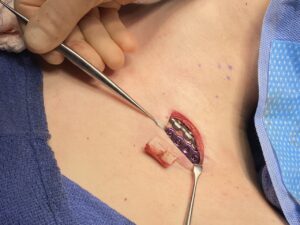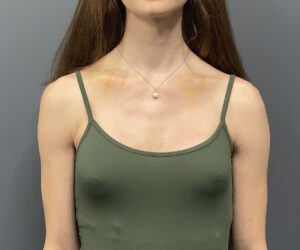Background: Shoulder narrowing surgery works by its obvious shortening of the horizontal length of the clavicle bone. In so doing the most critical step is putting back together the bone with its new shortened length using plate and screw fixation. That step is what most significantly differentiates it from clavicle fracture repair where the goal is to restore natural bone length from collapse of the fracture rather than to ‘unnaturally’ shorten the length of the clavicle..
When the two ends of the shortened clavicle bone are brought together they usually are now not of the same size. Their cross-sectional diameters are different. It is remarkable that with an average 15% loss of clavicle length the size of the distal end of the bone becomes so much smaller compared to the proximal end oil the cut bone..This is not apparent on the superior surface where the primary fixation plate is applied. It is seen on the underside of the bone surfaces. What this would suggest is that, although the bone ends will go on to complete healing across their new union site, the full cross-sectional diameter of the bone is never fully restored.
The transfemale clavicle bone is typically smaller than that of cis-male. This is undoubtably created by hormone therapy and can be exaggerated with weight loss and lack of strenuous physical activity. With the loss of bone volume the typical flat surface on the top of the clavicle bone may be lost. (becomes more rounded) This may necessitate some modifications in the application in the plate and screw fixation.
Case Study: This tall thin female was bothered by her square shoulder appearance. With a bideltoid width of 47cms her shoulders appeared very square-shaped which was magnified by her thin frame. Her thin frame also made for considerable clavicle show given the thin overlying soft tissues laye.




In the thin patient with a narrow bone diameter and very visible clavicles an important postoperative question is whether the fixation hardware will eventually seen. Will the clavicle bone just look thicker or will it be actually visible. Time and healing will answer that question but it is fair to advise the patient that their risks are higher for potentially needing secondary hardware removal.
Case Highlights:
1) Shoulder narrowing surgery is most frequently performed on transfemales who usually have clavicle bones with greater thicknesses. (cross-sectional diameters)
2) Hormone therapy and weight loss can cause a loss of bone thickness resulting in a thinner clavicle and a rounder bine shape.
3) A thinner clavicle bone will still have a significant marrow space and a rounder top surface posing some technical challenges in plate and screw fixation.
Dr. Barry Eppley
World-Renowned Plastic Surgeon





